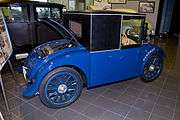Hanomag 2/10 PS
The Hanomag 2/10 PS was an economy car manufactured by Hanomag from 1924 to 1928.[2][3] It was one of the first cars with envelope styling.[3] It was affectionately referred to as the "Kommissbrot" or "Loaf of Rye Bread" due to its small squarish shape.
%2C_500_cm%C2%B3%2C_Bj._1927_(2007-06-16).JPG)
Drivetrain and radiator of a 2/10 PS
The 2/10 PS (two taxable / ten brake horsepower) had a single-cylinder half litre engine at the rear. The rear axle was chain-driven, with no differential.[3] With a fuel consumption of 4.0 litres per 100 kilometres (71 mpg‑imp; 59 mpg‑US) it was the world's most fuel efficient mass-production car between the two World Wars due to the low-friction one-cylinder engine and its very light weight.[4]
The fenders, or wings, of the 2/10 PS were integrated into the bodywork of the car, allowing the passenger space to be wider than it would have been with the traditional separate fenders and running board.[2] The compact drivetrain allowed the floor to be lower, making it possible to enter the car from the ground without a running board. The rounded appearance of the 2/10 PS, due to the envelope styling, earned it the nickname Kommissbrot after the inexpensive, flat-sided bread used by the military.[2][3]
The 2/10 PS faced competition from the Opel Laubfrosch and the Dixi DA1 variant of the Austin 7 and was replaced in 1928 by the more conventional 3/16 PS model.[2][3]
| Racing version at Nürburgring |
| Racing version with a custom light-weight wicker body |
|
References



%2C_500_cm%C2%B3%2C_Bj._1927_(2007-06-17).jpg)
